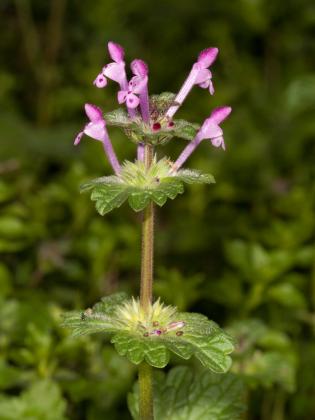Lamium amplexicaule – Cool season non-minty minta
Lamium amplexicaule, henbit, is native to Eurasia and Africa but is common in Grimes County lawns beginning in the fall. It’s a cool season plant and by late spring it’s usually too hot. In the Lamiaceae or mint family, henbit has an erect reddish square stem 4 to 8 inches tall. Its slightly hairy opposite leaves, round, wrinkly and scalloped, are about 1 ½ inches. The ones at the bottom have petioles, stems, while those at the top do not. They clasp the stem and often look like one round leaf with the stem going through it. You will be able to see the stem between the bottom and top leaves. This, the erect stem and its round leaves distinguish henbit from lookalikes.
Henbit’s dark pink to purple, two-lipped tubular flowers resemble a tiny orchid. They have bright purple spots and grow in a whorl of six to 10 above the upper leaves. They’re ½ to ⅝ inches long with hairs on top. The buds look like deep red dots. Seeds are in a pod. Each plant can produce from 200 to 2000 seeds. The plant has a shallow taproot that becomes finely branched. Henbit also spreads by producing roots on lower stems that touch the ground. When there are not many pollinating insects, the flowers self-pollinate.
Lamium is Latin for “gullet” and refers to the long throat-like flower tube. Amplexicaule means “clasping the stem,” referring to the upper leaves. The common name henbit refers to the fact that chickens enjoy the plant but so do other critters including man. The whole plant is edible. Even though it’s in the mint family, it does not taste nor smell like mint to me. It can be eaten raw. You can also put it in your cook pot. There are many recipes online for hen-bit pesto, quiche, smoothies, etc. The plant is in the Food and Drug Administration Poisonous Plant Database at fda.gov.
Traditional systems use henbit as an insect repellent and medicinally for diabetes, skin irritations, as a compress for swelling, etc. Henbit seed oil is being studied for its antioxidant properties. Two of several articles mentioning henbit from the National Institutes of Health, ncbi.nlm.nih.gov, are:
• “An ethno-medicinal study of medicinal plants used for the treatment of diabetes”.
• “Lamium Plants—A Comprehensive Review on Health Benefits and Biological Activities”.
The following two articles from the U.S. Forest Service, fpl.fs.fed.us, mention henbit:
• “Income Opportunities in Special Forest Products”. This document identifies plants that may help rural people supplement their incomes.
• “Forest Botanicals as Flavorings, Medicinals, and Pharmaceuticals”.
Henbit is probably in your lawn even though you keep mowing it down. Think about giving it a chance before using your weed eater on everything along the edges. It helps prevent soil erosion. It produces nectar for bees, hummingbirds, etc. in months where there may be little else in bloom. Henbit is listed in the Texas A&M University document “Central Texas Bee-Friendly Plants” at aggie-horticulture.tamu.edu .
Deborah Richardson is a freelance reporter for The Examiner with a fondness for flora in its natural setting.


